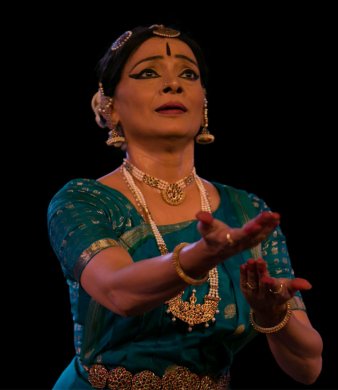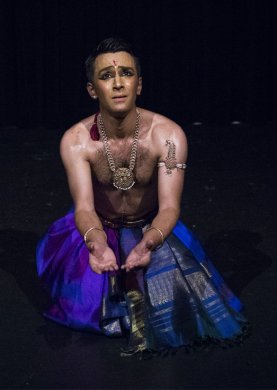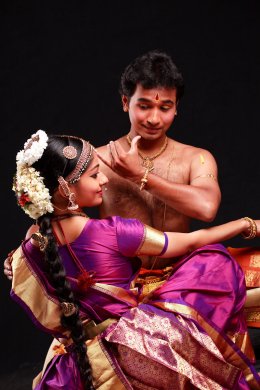
|   |

|   |
 e-mail: leelakaverivenkat@gmail.com Malavika's new creative spurt March 8, 2018 Dancing with greater energy than ever, Malavika Sarukkai seems to be going through a fresh spurt of creativity, breathing new life into her Bharatanatyam art. Performing on Feb 25 at Sannidhi Auditorium of the Gandharva Mahavidyalaya with its intimate ambience and an audience of discerning art lovers, Malavika's recital had an electrifying start with Sthiti Gathi, a work done a few years ago. Based on music in Madhuvanti composed by Prof C.V. Chandrasekhar, the dancer sculpts space with form, movement and stillness as two sides of a coin not only needing each other, but their contrasting natures enabling both to draw their own individual identities, from the other. And exploring this principle through the technique of Bharatanatyam lines and rhythm, Malavika has created movement of visual geometry, which holds the viewer spellbound with energy packed movements dotted with the silence of sudden freezes. The designing with accented points of movement beautifully echoed in the nattuvangam by Sreelatha (with mridangam and music in sync) with footwork of rhythmic phrases of syllables at cardinal points, doubled or trebled, along with the perfect symmetry of stances, made for dramatic fare.  Photo: Shalini Jain Darshan and Gangavataram, with the Bhagirathi and Alakananda meeting at Devaprayag to become the eternal Ganga, her tempestuous flow controlled in the locks of Shiva, a recent creation of the dancer dedicated to her late mother, was another uniquely imaginative production where Bhagirathi's stately flow as the older river contrasts with the sensuous curving grace of the Alakananda as she flows down the hills to the plains. Starting with the sonorous epithets to Shiva - Gangadhara, Neelakantha, Trinetra, Jatadhara Harahara Sambho, M.S. Sukhi's music in Saraswati and Nalinakanthi beautifully sung by vocalist Murali Parthasarathy with delightfully mellifluous violin touches by Srilakshmi Venkataramani, with rhythm having its own tonal variations in the mridangam of Nellai Balaji, had the dancer bringing out the personalities of two as they merge to become Ganga. From the plains of Devaprayag, the dance concentrated on the streets of Mythila, rendering one of Malavika’s oft rendered items inspired by the poetry of Kamban, describing women responding to the divine figure of Rama casually walking, his eyes interestedly looking at the city he has never visited before. Malavika’s interpretation caught how some women looked with beckoning eyes and others came leaping like graceful gazelles and peacocks while some others rushed by like streaks of lightning. The dance catches how eyes that fall on any part of Rama's body remain riveted at that spot, so perfect was it. Tol kandaan, tole kandaan go the famous lines of the poet speaking of how eyes which fell on those perfect shoulders remained glued to the spot. In the perfection of each part, the women saw the whole. With music in Panthuvarali composed by Prema Ramamurthy, even this oft rendered item acquired a special glow in this performance, perhaps because of the enthusiastic audience response. Bhavayami Raghu Ramam is one of the dancer's favourite items. But she introduced a prelude done to a viruttam, wherein the mother seems to have an insight into the divine nature of her child - the state of consciousness quickly hidden in present awareness of Rama as her child. The program had a power packed conclusion in Varaha based on verses from Tirumazhisai Alwar, for which the research was by Dr. Raghuraman with Dr. Vanati Raghuraman setting the music in forceful Athana and adi tala. Not an avatar which has been frequently explored in a complete dance item, Malavika brought to it a strong energy as Varaha pulls Bhoomi Devi from the watery depths to hold her aloft - dry and safe, perched on his snout. Definitely a special evening! Impressive start to Kalavahini's sponsorship of excellence in dance By all yardsticks, it was an impressive start on Feb 23 at the IIC auditorium for the Kalavahini Trust (Malavika Sarukkai's brainchild) in its goal of sponsorship and support for young excellence in dance - comprising passionate, committed and thinking dancers. Other envisaged programmes include Dance Immersion with four intensive days of interaction on dance matters, fellowships and financial support to help ease the burden while creating new productions. The two selected dancers for the evening were the already well known couple of Chennai, Shijith Nambiar and Parvati Menon with the other performer Christopher Guruswamy being one beginning to establish himself as a promising solo dance talent - all the dancers, coincidentally with a Kalakshetra background.  Christopher Gurusamy Christopher's dance has a passionate vigour, his clean sarukkal-s, powerful leg stretches and spirited toe/heel tattumettu-s ideally suited to the Nadanamaadinar start in Vasantha to the evening, portraying the power of Nataraja's dance. Murali Parthasarathy's involved vocal support, with the rest of the musical crew of Karthik Ramanathan (mridangam), Eshwar Ramakrishnan (violin) and Sudharshini (nattuvangam) rendered the right kind of inspirational accompaniment. With his energetic nritta scaffolding to the dance, Christopher's interpretative dance (which seemed a pale also ran even when witnessed during his solo recital for the Chennai Music Academy festival in January) would seem to be evolving fast under the tutelage of abhinaya guru Bragha Bessell, gauging by the dancer's animated interpretation of the love struck nayika pining for Padmanabha, in the Karnataka Kapi varnam of Swati Tirunal, "Sumasayaka." The Sanskrit sahitya here beyond expressing the heroine assaulted by the love darts of Manmatha, living in her mind the ecstasy of being with her lord, is sufficiently vague for the dancer to widen the abhinaya scope with an imaginative sub-text - which is what Christopher did with his interpretation, showing the nayika sending a letter of love through the parrot as messenger to the Lord. In the line Ramani mani shayana the teeth, the smile, the lotus eyes of the lord reposing as Anantashayana, and later Manmatha astride his chariot assaulting the nayika with his arrows, were all portrayed with passion. But the best of the abhinaya came in the post varnam phase, Aadahodalle makkalu, a Purandhara Dasa devarnama in Ragamalika, portraying the sulking, slightly perplexed, disgruntled boy Krishna, complaining to Mother Yashoda that his playmates always whispered amongst themselves about his being dark unlike brother Balarama, saying that he is not born to Yashoda but to some Devaki and Vasudeva incarcerated in jail and that as a baby, while being suckled, he sucked out the life force of a demon Putana. The dancer's abhinaya very persuasively caught the pouting little boy refusing to go and join his companions in play.  Shijith Nambiar and Parvati Menon Shijith and Parvati, despite the latter being slightly shaky and not cent per cent after her recent indisposition, made a spirited duo, combining in an arresting tandava/lasya blend holding audience attention. The beginning using the tam dhit tam kitataka thai dhit tai Alarippu sollus, in a changed setting with different movements invoked Shiva worship from the form to the formless, with the music going from Kamboji to Nattai, the iconographic symbols of anthropomorphic Shiva at first changing to worship of the lingam. While the music support for the couple comprised the earlier musicians Kartik Ramanathan on mridangam and Eshwar Ramakrishnan on violin, the vocalist was Binu Venugopal with nattuvangam by Venkatakrishnan Mahalingam. Vanajaksha, the varnam in Behag by T.R. Subramaniam, in the duo's interpretation acquires a dramatic start with the nayika's senses roused by the aroma of sandal paste, sounds of ankle bells, sight of a peacock feather, ending disappointingly with Krishna in his maya doing the disappearing act. The interpretation at times solo and at others as a narrative between the two, with the musicians in perfect sync with the dancers in passages like Sanakadi muni sannutapada made for evocative moments. The sundara sporting with the gopis, with a glimpse of the dashing Krishna responding to Rukmini's desperate call of love and distress, were all performed with the dancers enjoying every moment of the presentation. The interspersed teermanams with fine nattuvangam utterance, divided between two dancers, even while Parvati was not in crying form, had constant variations woven into footwork in double or treble speed in places and the dancer moving away now and then from the strict frontal dancing, the constant original touches never allowing the boredom of sameness to creep in. Venugopal's mellifluous singing was all to the good. Shijith's deeply internalised call to Pazhanimalai Muruga, the husband of Valli and Devayani, in the Varali Kanda Va Va Muruga was extremely moving. The concluding touch to a well attended, regaling evening with joyous dancers, was the rendition of Veena Seshanna's tillana composition in Senjurutti set to adi talam.  Writing on the dance scene for the last forty years, Leela Venkataraman's incisive comments on performances of all dance forms, participation in dance discussions both in India and abroad, and as a regular contributor to Hindu Friday Review, journals like Sruti and Nartanam, makes her voice respected for its balanced critiquing. She is the author of several books like Indian Classical dance: Tradition in Transition, Classical Dance in India and Indian Classical dance: The Renaissance and Beyond. Post your comments Please provide your name and email id when you use the Anonymous profile in the blog to post a comment. All appropriate comments posted with name & email id in the blog will also be featured in the site. |